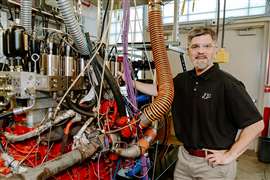Purdue leads research in better on-road diesel efficiency
15 June 2023
A national effort between Purdue University and industry stakeholders is exploring the reduction of carbon dioxide, nitrogen oxide and microscopic particle emissions and improving efficiency of diesel engines currently on the road.
 Purdue’s Greg Shaver has conducted research that has enabled diesel engine efficiency and emissions control through variable valve actuation. (Photo: Purdue University)
Purdue’s Greg Shaver has conducted research that has enabled diesel engine efficiency and emissions control through variable valve actuation. (Photo: Purdue University)
Greg Shaver, a mechanical engineering professor and director of Purdue’s Ray W. Herrick Laboratories, said there should not have to be a trade-off between protecting the air and achieving better engine efficiency of large on-road vehicles.
“There was this expectation even two years ago that you have to trade off nitrogen oxide and particulate matter with carbon dioxide because the work to make the diesel engine cleaner would also make the engine less efficient, resulting in more carbon dioxide,” Shaver said. “But what we’ve shown in our work at Purdue – through support from, and collaboration with, the U.S. Department of Energy and industry leaders Cummins Inc. and Eaton – is there is advanced technology that can be used to improve these important engine and aftertreatment systems.”
Shaver’s research has enabled diesel engine efficiency and emissions control through variable valve actuation (VVA). VVA allows for increased efficiency of diesel engines by utilizing cylinder deactivation and other methods during engine idling, low-load operation and highway cruise conditions, Shaver explained. It also enables the faster warmup of catalysts for effective reduction of an engine’s nitrogen oxides and microscopic particle emissions.
The research being conducted at the university has garnered attention from the U.S. Environmental Protection Agency (EPA). In December, the EPA finalized stringent new tailpipe emissions requirements for trucks, based in part on research done by Shaver and his team at Herrick Labs, Purdue said.
“Affecting the finalization of more stringent environmental regulations for heavy-duty engines and vehicles is probably the greatest kind of impact that someone with my research focus can have,” Shaver commented. The new regulations take effect in 2027, meaning there is a lot of work to be done to make diesel engines work robustly and meet these requirements, he added.
Shaver’s work was also previously cited in landmark regulation passed in California for on-road heavy-duty trucks in 2020, focused on reducing tailpipe nitrogen oxide emissions.
The research being conducted at Herrick Labs extends back to 2006 and is part of ongoing collaborations with the U.S. Department of Energy and industry leaders including Cummins Inc., Caterpillar, Deere, Allison and Eaton. Efforts are focused on off- and on-road high-efficiency natural gas, hydrogen and diesel engines – including those incorporated as part of a hybrid-electric powertrain.
STAY CONNECTED




Receive the information you need when you need it through our world-leading magazines, newsletters and daily briefings.
POWER SOURCING GUIDE
The trusted reference and buyer’s guide for 83 years
The original “desktop search engine,” guiding nearly 10,000 users in more than 90 countries it is the primary reference for specifications and details on all the components that go into engine systems.
Visit Now
CONNECT WITH THE TEAM










